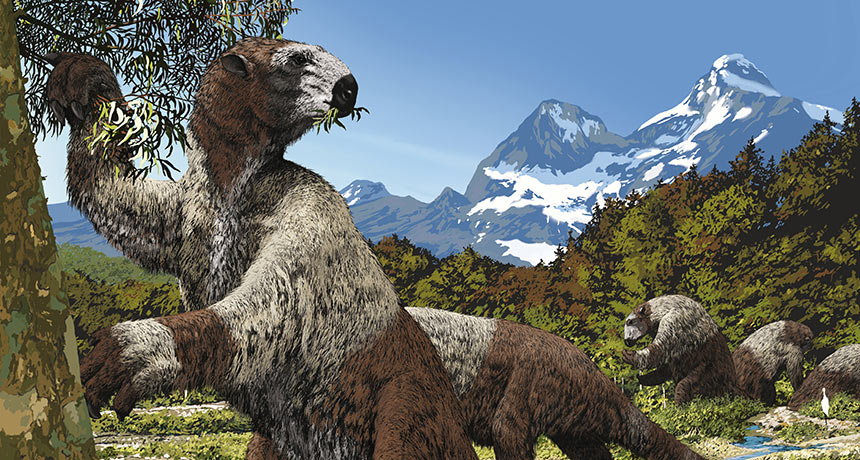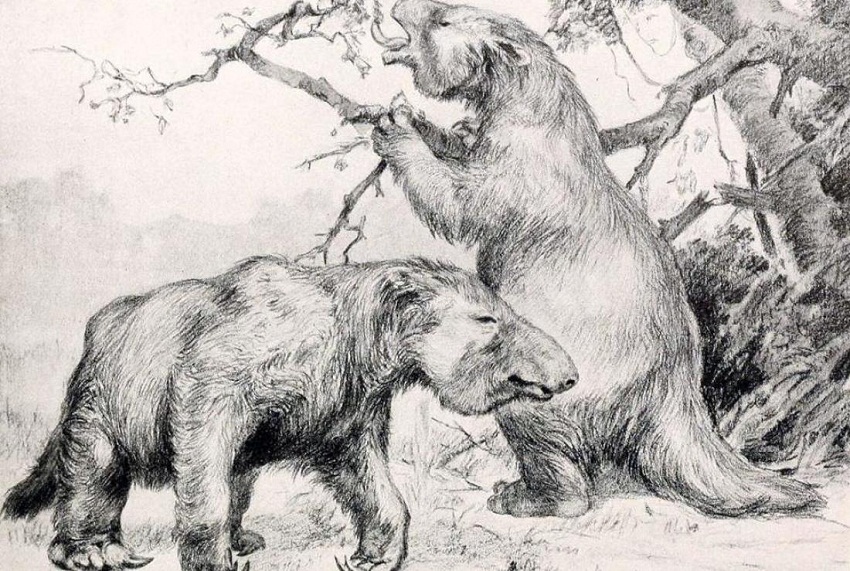

Some scientists believe that sloths may have supplemented their diet with meat, either taken from already killed animals, the sloths acting as scavengers and scaring away predators with their vicious claws and size when reared up, or killing animals with those same long, sharp claws, after rolling over a giant armadillo, for example, and stabbing its soft underbelly. Megalonyx, a smaller genus in North America, may have eaten willow leaves and twigs, or other trees growing in moist places, rising up to pull down branches and break them off or strip them. Paramylodon harlani, a species widespread in North America, had teeth that suggeted it grazed on grasses. Fossilized dung from a southwest American species shows it ate mesquite, cacti, agave, yucca, and Joshua trees. Sloths had hip bones that allowed them to stand up to reach higher branches, strong claws to rib off bark and tear down limbs, and small blunt teeth to grind up fibrous plant tissue. So, take a moment to settle back into your childhood sense of wonder and delight at the unknown as you enjoy a few of these articles, next.Answer: tree leaves, some other grasses and local plants, possibly a little meat As adults, we can see these skeletons and let our imagination and our curiosity run free, too.
GIANT SLOTH SIZE LICENSE
Our ancient ancestors would have even walked beside them in some cases! We don’t have to be children who still have their license to imagine fantastical creatures to be enthralled by giant sloths, giant armadillos, or dinosaurs. These animals seem fantastical, but in the span of life on this earth, we are still so close to them. Could it be that we are so enthralled by these long-ago species because they allow us to imagine the world we know in new ways? What if mastodons roamed the plains of North America as elephants do in Africa today? What if that sound crashing through the woods wasn’t a moose, but, instead, a giant sloth? There has to be a reason why kids love dinosaurs, why some of us humans adore roaming the halls of natural history museums, and why we’ll spend hours watching movies about bringing ancient animals back to life. It was challenge 7 and way stronger than I intended, but I liked the. I added a couple abilities from a giant sloth statblock I found online-I think it may be from the Creature Codex but cannot confirm.

What do we learn from the species that have disappeared? (Note: I started with the polar bear stats, since as far as I can tell most of these things were about the size of a very large bear or bigger. Oh, and if you want to check out a video that goes into even greater depth about the incredible number of ancient sloth species I mentioned at the top of the article, give this video from PBS Eons a watch! It’s a truly fantastic look at the diversity of sloth species that once lived on this planet. With content that spans literature, archaeology, science, and so much more, it’s the place to go to learn more about the world! The footprints are shallow, about 1.2 inches (3 cm) deep, but it seems that was deep enough for them to fill with water and intrigue the children. The 2014 discovery of 27,000-year-old fossils of a giant ground sloth was purely coincidental. Julie McMahon, University of Illinois at Urbana-Champaign A size comparison depicting an average adult man with the giant, 13-foot sloth. If you are a curious person or know of one, TED-Ed is one of the best YouTube channels out there to explore. Each of the giant ground sloth footprints measures nearly 16 inches (40 centimeters) long, and the beast would have been anywhere from the size of a cow to as big as a bear, Bennet said. The giant sloth was allegedly up to 20 feet long, stood 13 feet tall, and weighed around 14,400 pounds. While the sloths we know today are still fascinating, their ancient relatives once dominated an impressive range of habitats across North America, from the mountains to the sea! And yes, this is one tale that’ll have you looking at your avocados with a little more awe. Sloths? Those slow things that live in trees that can barely do anything? Well, yes, actually. No, these are the fossil remains of a creature you’d never expect to find in North America today: sloths. What was this giant creature? And what does it have to do today with, of all things, avocados? This, my friends, isn’t some fairy tale, but a mystery you’ll want to come along with!Īll this talk of sharp claws and massive sizes may have you wondering, what kind of creatures are we talking about!? Well, my friends, we’re not talking about giant wolves, lions, or bears.

With gigantic claws and confusingly large limbs, its enormous size puzzled and even struck fear into the hearts of American explorers. Once upon a time, a massive creature roamed the Americas.


 0 kommentar(er)
0 kommentar(er)
